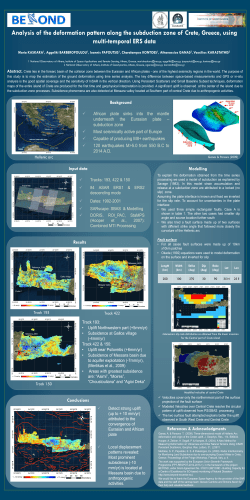
Full text
Research Article ISSN 2336-9744 (online) | ISSN 2337-0173 (print) The journal is available on line at www.ecol-mne.com http://zoobank.org/urn:lsid:zoobank.org:pub:F66A0ECF-322D-4A16-8DA1-936D17685072 Description of Planorbis cretensis n. sp. from Crete (Gastropoda: Planorbidae) PETER GLÖER1 and HANS-JÜRGEN HIRSCHFELDER2 1 2 Schulstraße 3, D-25491 Hetlingen, Germany; e-mail: [email protected] Schützenstr. 2, D-93309 Kelheim, Germany; email: [email protected] Received 1 March 2015 │ Accepted 4 March 2015 │ Published online 5 March 2015. Abstract A new Planorbis sp., P. cretensis n. sp., is described from a material collected in Crete. The new species is compared with two other small species of the genus occuring in the Mediterranean region, Planorbis agraulus from Algeria and P. moquini from Corsica. Key words: Crete, Planorbis, new species, Mediterranean. Introduction The small species of the genus Planorbis, i.e., P. agraulus Bourguignat, 1864 and P. moquini Requien, 1848 occurring in the Mediterranean region have often been confused with Gyraulus laevis Alder, 1838. MeierBrook (1983: 38) was the first who revealed that these species belong to the genus Planorbis. Planorbis agraulus was redescribed by Glöer & Bouzid (2008) based on material from Algeria, while P. moquini from Corsica was redescribed by Glöer & Zettler (2009). The both abovementioned species, P. agraulus and P. moquini are different from a small planorbid species living in Crete. The latter species from Crete has possibly been mentioned by Meier-Brook (1976: 110, table 1) as Planorbis atticus Bourguignat, 1852. However, Bourguignat (1852: 22) described Planorbis atticus as a species of large dimensions with a diameter of 8 mm and a shell height of 2.5 mm. The latter species recently has been redescribed by Glöer & Pešić (2010). The distinctness and relation between the Planorbis species from Crete to other small Planorbis spp. from Mediterranean islands has already been discussed by Glöer & Zettler (2009). This paper is intended to describe Planorbis cretensis n. sp. from Crete. Material and Methods The snails were recently collected by the junior author and has been fixed in 75% ethanol. The dissections and measurements of the genital organs and the shells were carried out using a stereo microscope (ZEISS); the photographs were made with a digital camera system (Leica R8). The type material is stored in the Zoological Museum of Hamburg (ZMH), Germany. Ecol. Mont., 2 (2), 2015, 109-111 NEW PLANORBIS FROM CRETE Systematics In the Planorbidae the features of distinct species are sometimes not well pronounced, so we have to weigh up distinct features more precisely. One suitable feature to distinguish planorbid species is the number of prostate diverticules which is not correlated with the age or size of a species (Meier-Brook 1976: 113). In addition we used the shell shape to distinguish P. cretensis n. sp. from other small planorbid species of the Mediterranean. Genus Planorbis O.F. Müller, 1773 Type species Planorbis planorbis (Linnaeus, 1758) Planorbis cretensis n. sp. (Fig. 1) Type series. Holotype (ZMH 79836): Shell height 2.9 mm, shell width 1.0 mm; Paratypes (ZMH 79837): 3 specimens from type locality (coll. Glöer 1 ad., coll Hirschfelder 5 ad., 9 juv.). Locus typicus. Greece, Topolia, 9 km south of Kissamos, W-Crete, spring in village, 35°25'46.4" N, 23°41'07.1" E, alt. 260 m asl., 16.10.2014 Andrea and Hans-Jürgen Hirschfelder leg. Description Shell: The horn-coloured shell is glossy, finely striated, and the 3.5 whorls increase regularly. The whorls are on the upper side regularly convex with a deep suture, on the underside the whorls are slightly flattened. The first whorls on the upper side are deep and the underside is widely umbilicated. The aperture is oval and not deflected. The diameter of the shell is 2.8-3.0 mm, and the height of the last whorl is 0.9-1.0 mm. Animal: The animal is light grey, the mantle pigmentation is light and without patterns. Anatomy: The preputium is dorsal dark pigmentated, the penis sheath is twice to three times longer than the preputium, and as slender as the vas deferens. The prostate gland bears 18-20 diverticula. The bursa is of tadpole type with a thin bursa duct. Etymology. Named after the island where the species was found. Figure 1. Planorbis cretensis n. sp. from Crete. Abbreviations: bc = bursa copulatrix, pht = phallotheca, pr = prostate gland, prp = praeputium, v = vagina. 110 GLÖER & HIRSCHFELDER Differentiating features. The new species from Crete can be distinguished from Planorbis moquini and P. agraulus by the number of prostate diverticules (11-13 in P. moquini and 18-24 in P. agraulus, data taken from Glöer & Zettler (2009) and Glöer & Bouzid (2008) respectively). In P. moquini the mantle is dark grey, while in P. agraulus and in P. cretensis n. sp. it is light. The whorls in P. agraulus are more convex, especially on the underside, as in P. cretensis n. sp. Habiat. The species was found to live on dead leaves in a captured spring (Fig. 2) beside the main road in the village Topolia together with Pseudamnicola brachia (Westerlund, 1886). Distribution. Crete; known only from the locus typicus. Figure 2. Left: Spring in Topolia, type locality of Planorbis cretensis n. sp. Right: Andrea Hirschfelder collecting Planorbis cretensis n. sp. References Bourguignat, J.R. (1852) Testacea novissima quae Cl. de Saulcy in itinere per Orientem annis 1850 et 1851, collegit. 31 pp. Glöer, P. & Bouzid, S. (2008) Redescription of Planorbis agraulus Bourguignat, 1864 (Gastropoda: Planorbidae). Journal of Conchology, 39, 487–491. Glöer, P. & Pešić, V. (2010) The Planorbis species of the Balkans with the description of Planorbis vitojensis n. sp. (Gastropoda: Planorbidae). Journal of Conchology, 40 (3), 249–257. Glöer, P. & Zettler, M.L. (2009) Redescription of Planorbis moquini Requien, 1848 (Gastropoda: Planorbidae). Journal of Conchology, 39, 727–732. Meier-Brook, C. (1976) The generic position of Planorbis (Gyraulus) intermixtus Mousson, 1874, and Planorbis presbensis Sturany, 1894 (Gastropoda, Basommatophora). Basteria, 40 (4/6), 107–118. Meier-Brook, C. (1983) Taxonomic studies on Gyraulus (Gastropoda: Planorbidae). Malacologia, 24 (1-2), 1–113. Ecol. Mont., 2 (2), 2015, 109-111 111
© Copyright 2025



















